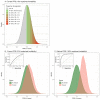Risk Prediction Using Polygenic Risk Scores for Prevention of Stroke and Other Cardiovascular Diseases
- PMID: 34399584
- PMCID: PMC7611731
- DOI: 10.1161/STROKEAHA.120.032619
Risk Prediction Using Polygenic Risk Scores for Prevention of Stroke and Other Cardiovascular Diseases
Abstract
Early prediction of risk of cardiovascular disease (CVD), including stroke, is a cornerstone of disease prevention. Clinical risk scores have been widely used for predicting CVD risk from known risk factors. Most CVDs have a substantial genetic component, which also has been confirmed for stroke in recent gene discovery efforts. However, the role of genetics in prediction of risk of CVD, including stroke, has been limited to testing for highly penetrant monogenic disorders. In contrast, the importance of polygenic variation, the aggregated effect of many common genetic variants across the genome with individually small effects, has become more apparent in the last 5 to 10 years, and powerful polygenic risk scores for CVD have been developed. Here we review the current state of the field of polygenic risk scores for CVD including stroke, and their potential to improve CVD risk prediction. We present findings and lessons from diseases such as coronary artery disease as these will likely be useful to inform future research in stroke polygenic risk prediction.
Keywords: cardiovascular disease; genetics; myocardial infarction; risk assessment; stroke.
Conflict of interest statement
GA reports speaker honoraria from Amgen One Cardiovascular Academy outside the submitted work. LRJ is a full-time employee of Hoffmann-La Roche Ltd. MI reports no conflicts of interest.
Figures

References
-
- Meschia JF, Bushnell C, Boden-Albala B, Braun LT, Bravata DM, Chaturvedi S, Creager MA, Eckel RH, Elkind MS, Fornage M, et al. Guidelines for the primary prevention of stroke: a statement for healthcare professionals from the American Heart Association/American Stroke Association. Stroke. 2014;45:3754–3832. - PMC - PubMed
-
- Wolf PA, D’Agostino RB, Belanger AJ, Kannel WB. Probability of stroke: a risk profile from the Framingham Study. Stroke. 1991;22:312–318. - PubMed
-
- D’Agostino RB, Wolf PA, Belanger AJ, Kannel WB. Stroke risk profile: adjustment for antihypertensive medication. The Framingham Study. Stroke. 1994;25:40–43. - PubMed
-
- Goff DC, Jr, Lloyd-Jones DM, Bennett G, Coady S, D’Agostino RB, Gibbons R, Greenland P, Lackland DT, Levy D, O’Donnell CJ, et al. 2013 ACC/AHA guideline on the assessment of cardiovascular risk: a report of the American College of Cardiology/American Heart Association Task Force on Practice Guidelines. Circulation. 2014;129:S49–73. - PubMed
Publication types
MeSH terms
Grants and funding
LinkOut - more resources
Full Text Sources
Medical

